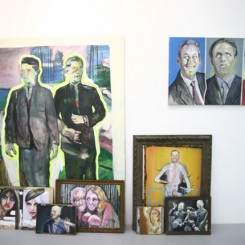“Vice,” Gao Weigang solo exhibition.
“As there is Paradise in Heaven,” Zhou Yilun solo exhibition.
Platform China (No. 319-1, East End Art Zone A, Caochangdi Village, Chaoyang District, Beijing 100015). Oct 20 – Dec 2, 2012.
The respective solo exhibitions by Gao Weigang and Zhou Yilun now on show make for a dramatic comparison.
On the left, Gao Weigang; here is represented the more industrial side of this versatile artist’s work, rather than the paintings or hand-hewn sculptures. Positioned firmly around the walls are definite shapes in stainless steel and titanium – a staircase in metallic emerald (an edition of the 2010 “Superstructure” series), and two flat discs; the first of these, in gold, intermittently whirs round rapidly thanks to a motor behind it, reflecting a round of light onto the floor in front. The other (purple) is stationary, pinioned in the centre with a thick, dark bolt. Elsewhere, that bolt appears again, but alone on the wall. There is also a gold unicorn skull, lying as if discarded with a black cord entwined through it. Across the final wall is a huge panel piece, wherein shattered fragments of a mirror have been affixed to a light blue painted background in patterns at once and acicular and decorative. Facing the staircase up to the first floor are also the disembodied stainless steel fastenings of a door re-composed directly on the wall. Underpinning the whole display is the continuous sound of a telephone ringing, its source hidden inside a single bamboo pole leaning in a corner – a masterpiece of intrigue, distraction and concealment, and not without humour.
On the right, Zhou Yilun, an artist whose robustly painterly approach is consistent with what one anticipates from Platform China – but whose caustic manner one doesn’t, necessarily. His paintings of various sizes, some with makeshift wooden frames and twine to hang them, others on segmented canvases or clustered together on the floor, are disparate yet consistent in the manner in which they seem to have been conceived. The references are often televisual or pertain to entertainment in other forms: trite filmic slogans and titles (“I Love You So Much,” 2012 – a couple embracing in water), bodies suspended in topical flux (the rush of media imagery to which we are accustomed, paused hastily in oils), their eyes perhaps whited out, or outlines etched shamelessly in thick white paint; also part of this discordant pantheon are nameless CEOs, Hitler and the Madonna and Child. Zhou’s is a satiric cast, punctuated with snatches of text – “BEIJING HEN GAN A” (Beijing is so dry!) is scrawled in black spray paint on the wall, the can hanging below (Zhou is from humid Hangzhou) – and sporadic eroticism within the compositions. It is an energetic performance and, again, not without humour.
If the above descriptions mirror each other in their endings, it is a rare parallel between the work of the two artists. For in other ways, their output is utterly different. The comparison of these simultaneous solo shows serves to emphasise the atmosphere at the core of each (throwing them into mutual relief), as well as the ways in which it is realised in terms of form. Gao Weigang’s is an acutely refined practice of which these minimal and economical – yet very potent – pieces are exemplary. Gao’s talent for distillation is marked – though at the same time, quite what has been distilled into concise works is often tantalisingly ambiguous. One detects Zhou Yilun’s comparative youth – he was born in 1983. His is an exhibition willingly engorged with contemporary mass-imagery, as if he is streaming it into oil paint. As yet unmentioned is an untitled installation within his show: with walls of old woven mattresses and an upended fairground animal statue inside supporting a makeshift fountain with rubber tubing, and figures embroidered into the sides with wool in the manner of his painted strokes, it is an eccentric and slightly sardonic play. A photograph of the artist, clutching one of a linked web of masking tape coils between his teeth so that they camouflage his face, its expression grinning through them, conveys his character; it also explains, in part, the rejection of reservation in his work.
Thus do these two exhibitions provide lively counterpoints; each is strong in its own manner, and seeing one nourishes the sight of the other. Worth remembering is that whilst artists, through their works, distil the environment, so too do viewers in terms of what they see of and in art, and what is then filtered through their perception of the contemporary context. Such juxtapositions as of these exhibitions are a welcome measure of possibility on both sides.
